Lawn Fungus Treatment
The broad definition of fungi is an organism that doesn't produce its own food, reproduces via spores, have cell walls that are made up of chiton and have cell nuclei. While that may sound like a lot, you'd be quite surprised to find out the common conditions and items that are caused as a result of fungi.
For example, did you know the yeast used to make beer is actually a fungus? Or that athlete's foot is caused by a specific fungus? The fungal kingdom is vast and wide with contributions to a lot of common aspects of society, including medicine, cheese and bread!
Lawn & Weed Expert offer a variety of fungus and mould treatments for lawns in Cardiff, Newport, Swansea and across South Wales.
For example, did you know the yeast used to make beer is actually a fungus? Or that athlete's foot is caused by a specific fungus? The fungal kingdom is vast and wide with contributions to a lot of common aspects of society, including medicine, cheese and bread!
Lawn & Weed Expert offer a variety of fungus and mould treatments for lawns in Cardiff, Newport, Swansea and across South Wales.
Different types of Garden Fungus and Mould

Mushrooms & Toadstools
Fungi are nature’s dustmen, converting dead organic matter into basic nutrients that re-enter the food chain and are eventually recycled. The appearance of a few mushrooms or toadstools on your lawn is a healthy sign – it means that fungi in your soil are active and breaking down (for instance) an old, buried tree root. The fungi that appear on the surface contain spores which are released into the atmosphere.
However, if your lawn has a heavy concentration of toadstools, a professional lawn fungus treatment programme may be necessary.
However, if your lawn has a heavy concentration of toadstools, a professional lawn fungus treatment programme may be necessary.
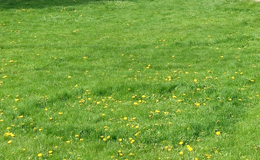
Fairy Rings
Fairy rings are easily identifiable by the circle of lush green growth surrounding an area of dead brown grass. The appearance may differ somewhat depending on the type of fungus responsible for the fairy ring.
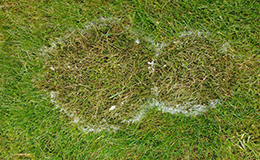
Fusarium Patch
Fusarium patch, also commonly known as snow mould, occurs during cooler times of year. Brown patches appear first, and these are followed by a fluffy white growth.
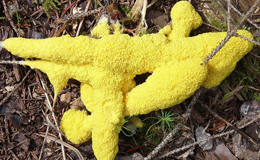
Slime Mould
Slime moulds survive the cold winter season in soil and thatches layers as spores. These spores then germinate during periods of cool, wet weather to produce other types of spores which feed on microorganisms and organic matter. Slime mould is not parasitic so will not cause any sort of plant disease. This garden fungus is typically found on the surface of mulch, plant stems, grass or wood chips.
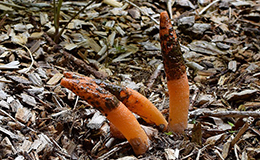
Stinkhorns
This type of garden fungus can be typically found in lawns around the base of dead trees or within flowerbeds that have been mulched with wood chips. They are often produced during cool, wet periods of weather during the late summer and autumn and cause no harm. Stinkhorns develop within a round or flattened egg, typically one to three inches in diameter in either a pink, white, lilac or beige colour.
Sphere Throwers/Cannon Fungus
Also known as Sphaerobolus, sphere throwers are a garden fungus commonly found growing on rotting wood. Their fruiting bodies have a white/pink/yellow colour to them that mature into a cup shape. As a result of growing pressure, the cup shape that they develop begins to turn inside out, giving them an unusual appearance. This fungus also does not harm any living plants.
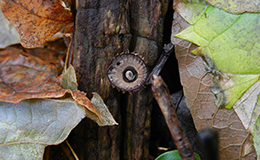
Bird's Nest Fungi
Similar to the sphere throwers above, bird’s nest fungi grows on the rotting wood that you have in your garden. As its name suggests, this fungi looks like a miniature bird's nest, so won't be very difficult to identify. It carries a light brown appearance but may also be yellow, grey or white. And just like Sphaerobolus above, because this is a fungus that lives on decaying plant matter, it will not cause any harm to the plants living in your garden.
